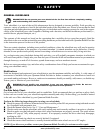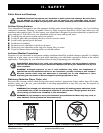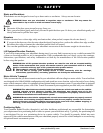
10 www.pridemobility.com Litestream Junior
II. SAFETY
Figure 1. Maximum Safe Slope (Ascending and Descending)
WARNING! If your wheelchair is equipped with a reclining seatback, do not attempt to negotiate
inclines with the seat in a reclined position. Do not attempt to negotiate obstacles with the seat
in a reclined position unless an attendant is present to help stabilize the chair. Failure to heed
may result in the wheelchair tipping over.
WARNING! If your wheelchair is equipped with an optional carry bag mounted to the seatback,
do not overload the bag or exceed the maximum load rating of the bag. Doing so could cause
instability in your wheelchair when negotiating inclines, causing it to tip.
WARNING! Even though your wheelchair is capable of climbing and descending slopes greater than
those illustrated in figure 1, do not, under any circumstances, exceed the incline guidelines or any
other specifications presented in this manual. Doing so could cause instability in your wheelchair.
Pride recommends that the maximum slope of an incline you attempt to safely ascend or descend on your wheel-
chair does not exceed 5° (8.7%). See figure 1.
WARNING! Any attempt to climb or descend a slope steeper than 5° (8.7%) may put your
wheelchair in an unstable position and cause it to tip.
WARNING! Any change to the center of gravity of your wheelchair may affect stability. Changes
to drive wheel position, camber, seat height, seat angle, and body position can affect stability.
Contact your healthcare provider to determine your specific requirements. Do not change your
seating configuration without first contacting Pride Mobility Products or your Quantum Rehab
Provider. The use of anti-wheels is recommended.
Braking Information
To stop the wheelchair, apply pressure to both handrims until the wheelchair comes to a complete stop.
Manual Wheel Locks
Your wheelchair is equipped with two manual wheel locks; one mounted near (or directly in front of) each drive
wheel. The manual wheel locks help prevent your wheelchair from moving when parked. After you bring your
wheelchair to a complete stop, engage both manual wheel locks. There are two types of manual wheel locks
available on your wheelchair: push-to-lock and pull-to-lock. If you have any questions about the operation of your
manual wheel locks, contact your Quantum Rehab Provider.
WARNING! Do not attempt to use either manual wheel lock lever to stop your wheelchair.
WARNING! Pride does not recommend that you remain parked on an incline for a long period of time.
WARNING! Use care when operating the wheel locks. Possible pinch point created during operation.
Cornering Information
While your wheelchair is equipped with caster wheels, excessively high cornering speeds can still create the
possibility of tipping. Factors which affect the possibility of tipping include, but are not limited to: cornering
speed, steering angle (how sharply you are turning), uneven road surfaces, inclined road surfaces, riding from an
area of low traction to an area of high traction (such as passing from a grassy area to a paved area – especially at
high speed while turning), and abrupt directional changes. High cornering speeds are not recommended. If you
feel that you may tip over in a corner, reduce your speed and steering angle (i.e., lessen the sharpness of the turn)
to prevent your wheelchair from tipping.
WARNING! When cornering sharply, reduce your speed and maintain a stable center of gravity.
This greatly reduces the possibility of a tip or fall.


















